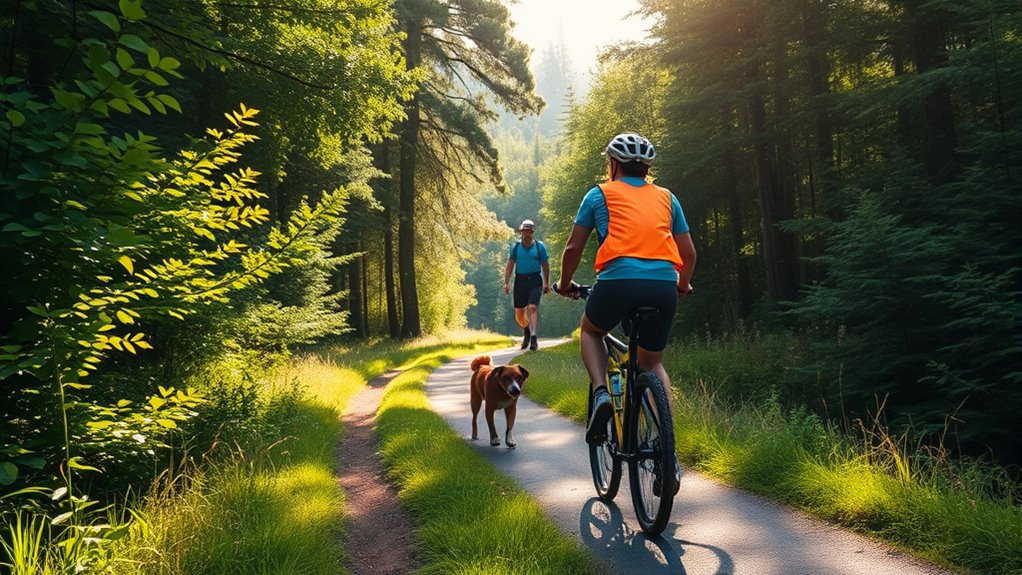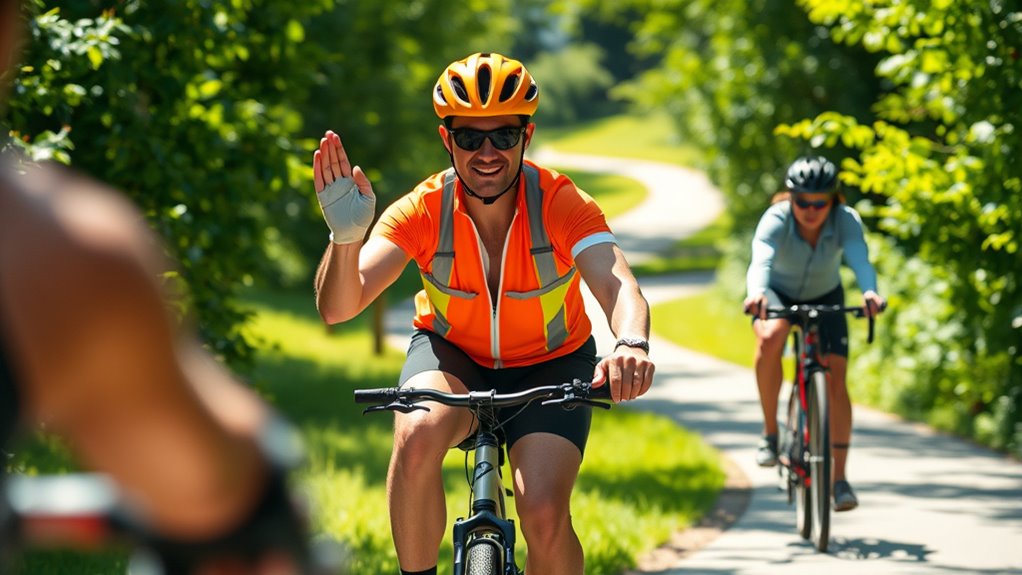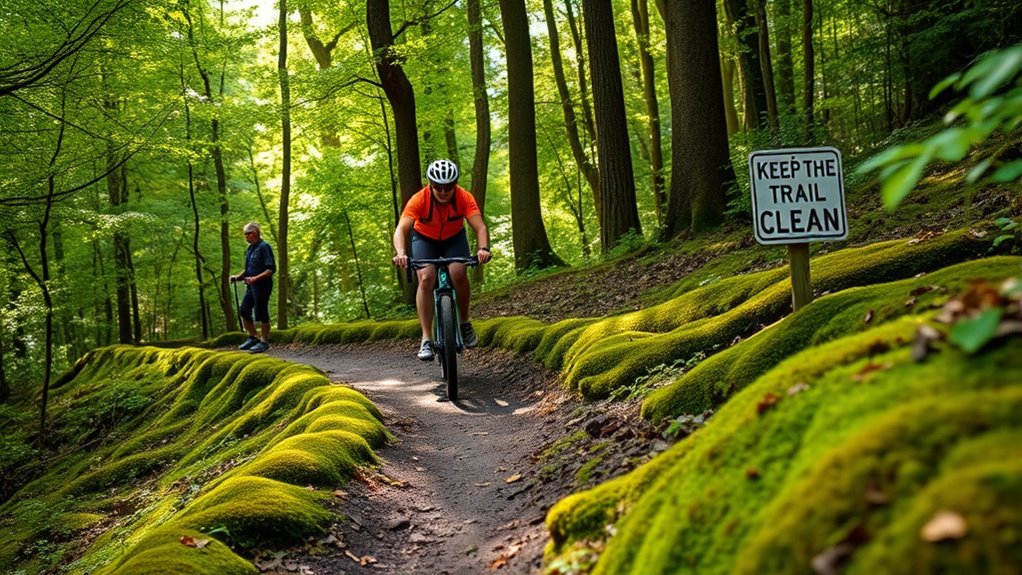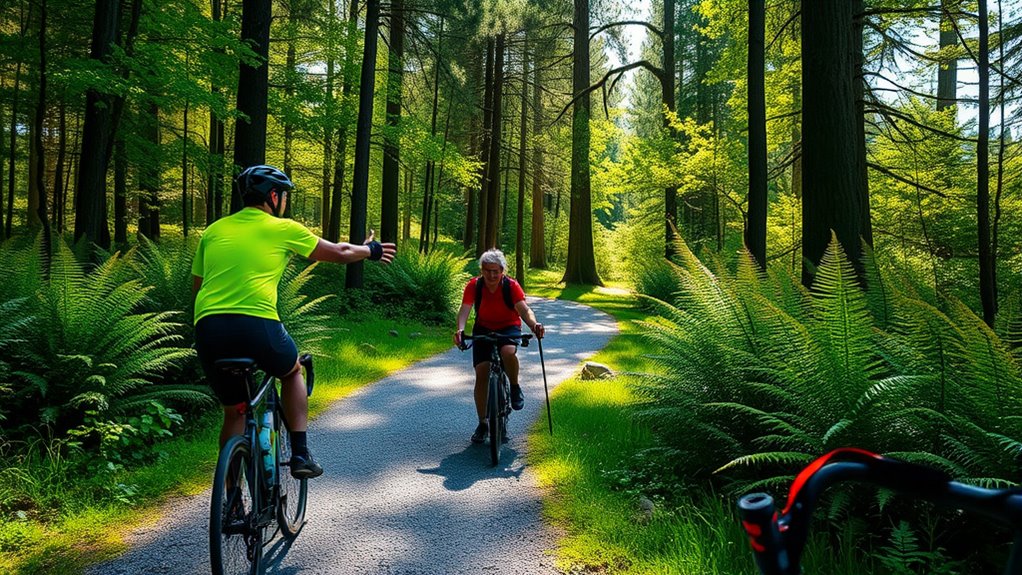On shared trails, you should always respect other users by controlling your speed, passing politely, and acknowledging pedestrians, runners, or cyclists. Communicate clearly with hand signals or verbal cues when turning or approaching others and stay alert to trail signs and markings. Keep your pace manageable, avoid sudden moves, and stick to designated paths. Remember to leave no trace by cleaning up and respecting the environment. To learn more about proper trail etiquette, keep exploring these key guidelines.
Key Takeaways
- Practice trail courtesy by acknowledging pedestrians, runners, and cyclists, and keep your speed in check when approaching others.
- Use clear hand signals and verbal alerts to communicate your intentions when passing or approaching others.
- Maintain control by braking smoothly, using both brakes evenly, and adjusting speed on technical or crowded sections.
- Follow trail signs and markings to stay on designated paths and prevent accidents.
- Keep the trail clean by carrying out trash and sticking to designated routes to protect the environment.
Respect the Trail Users and Their Space

To guarantee everyone can enjoy the trail safely, it’s important to respect other users and their space. Practicing trail courtesy means being aware of your surroundings and acknowledging the presence of pedestrians, runners, and fellow cyclists. Keep your speed in check, especially when approaching others, and give a friendly signal or call out if you’re passing. User awareness helps prevent accidents and creates a positive environment for all. Avoid startling others by riding unpredictably or too fast in crowded areas. Remember, everyone has a right to enjoy the trail, so share it responsibly. Respecting the space of others not only keeps everyone safe but also fosters a culture of mutual respect and consideration on shared trails. Additionally, maintaining proper trail etiquette helps support the overall health and sustainability of shared outdoor spaces.
Communicate Clearly and Use Your Voice

Effective communication is essential for safe and enjoyable trail sharing. Using clear verbal cues and hand signals helps prevent accidents and confusion. Here are four ways to communicate effectively:
- Use hand signals to indicate turns or stops, making your intentions clear to others.
- Verbally alert others when passing or approaching, especially in tight spots.
- Call out your presence when approaching from behind, so trail users can adjust.
- Confirm understanding by making eye contact or nodding when giving or receiving signals.
- Remember to keep awareness of your surroundings and respect the shared space to promote safety and harmony on the trail.
Maintain Proper Speed and Control

Maintaining proper speed and control is essential for safe trail sharing, especially in areas with many users or obstacles. To do this effectively, master braking techniques to slow down smoothly without skidding or losing balance. Use both your front and rear brakes gradually, applying pressure evenly to maintain stability. Good gear selection also plays a crucial role; shift to lower gears when approaching technical sections or downhill stretches to keep your speed manageable. Avoid riding too fast, especially on unfamiliar or crowded trails, to give yourself enough reaction time. Staying in control helps prevent accidents and ensures everyone can enjoy the trail safely. Remember, controlling your speed isn’t just about your safety — it’s about respecting others on the trail too. Additionally, being aware of your suction power and cleaning modes can help prevent sudden stops or distractions that might compromise your control.
Follow Trail Signs and Markings

Following trail signs and markings is key to staying on the right path and riding safely. Proper signage recognition helps you understand trail directions, warnings, and rules. Look for consistent marking patterns to avoid confusion and ensure smooth navigation. To do this effectively:
- Pay attention to trail signs indicating directions, speed limits, or hazards.
- Recognize color-coded markings that guide you along different routes.
- Confirm that markings are clear and consistent throughout the trail.
- Respect signage to prevent accidents and stay on designated paths.
- Understanding the influence of signage can improve your overall trail experience and safety.
Leave No Trace: Keep the Trail Clean

Ever wonder why keeping the trail clean matters? Maintaining trail cleanliness helps protect the environment and preserves the natural beauty for everyone. When you pick up your trash and avoid littering, you reduce the environmental impact and prevent harm to local wildlife. Carry out everything you bring in, including food wrappers, water bottles, and bike parts. Stick to designated paths to prevent erosion and damage to plants. Respecting the trail by leaving no trace ensures others can enjoy the same pristine experience. Your actions directly influence how healthy and sustainable the trail remains. By keeping the trail clean, you contribute to a safer, more enjoyable environment for fellow cyclists and the ecosystem alike. Remember, a clean trail is a responsible trail. Additionally, understanding the importance of trail maintenance can help you appreciate the collective effort needed to keep shared trails in great condition.
Frequently Asked Questions
What Should I Do if I Encounter Wildlife on the Trail?
When you encounter wildlife on the trail, prioritize trail safety and respect their space. Slow down or stop to observe wildlife observation quietly, avoiding sudden movements or loud noises that could startle animals. Keep a safe distance and don’t attempt to feed or approach them. By respecting wildlife, you’ll guarantee a safe and enjoyable experience for everyone, including the animals. Always stay alert and mindful of your surroundings.
How Do I Handle Conflicts With Other Trail Users?
Did you know that most trail conflicts stem from misunderstandings? When you encounter other trail users, stay calm and use courtesy gestures like a friendly wave or a verbal greeting to signal your intentions. Trail signaling, such as slowing down or passing on the left, helps prevent accidents. By communicating clearly, you foster a respectful environment, making the trail safer and more enjoyable for everyone.
Are There Specific Rules for Riding With a Group?
When you’re riding with a group, it’s important to follow formation rules to guarantee safety and smooth flow. Keep the group organized, usually in a single file or a double file on narrow paths. Communicate clearly with hand signals or calls, and maintain a steady pace. Stay alert for trail signs and other users, and be courteous. By respecting these group riding rules, you help everyone have a safe and enjoyable experience.
What Gear Is Essential for Safe Trail Riding?
Thinking about essential gear is like preparing your toolkit before a big adventure. You should carry trail maintenance supplies like a mini pump, spare tube, and multi-tool. Bike accessories such as a helmet, gloves, and lights boost safety and comfort. Always check your bike’s condition beforehand. Proper gear helps you stay safe, prevents breakdowns, and guarantees you’re ready for any trail challenge that comes your way.
How Do I Prepare My Bike for Different Trail Conditions?
To prepare your bike for different trail conditions, start with thorough bike maintenance, checking tire pressure, brakes, and gears. Adjust your suspension if needed for rough terrain, and carry tools for on-the-go repairs. Trail preparedness means knowing the trail type and weather forecast, so you can select appropriate tires and accessories. Staying proactive with maintenance and planning guarantees you ride safely and confidently through diverse trail conditions.
Conclusion
By following these trail etiquette tips, you help create a safe and enjoyable environment for everyone. Remember, nearly 70% of trail users value courteous behavior and clear communication. When you respect others’ space, control your speed, and keep the trail clean, you’re contributing to a positive experience for all. Keep these practices in mind, and you’ll guarantee shared trails remain fun, safe, and sustainable for future adventures.










